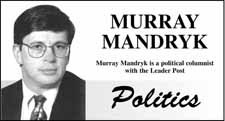By all the usual measurements, this has already been a very different Saskatchewan election campaign than maybe we're used to seeing.
In fact, you may have trouble recognizing it as a Saskatchewan election at all.
Gone - at least for now - is the nastiness we saw in the seemingly endless run up to the Oct. 10 election call. It may not last long, but niceness and policy debate are the order of the day in the Saskatchewan campaign right now. The NDP and Saskatchewan Party have eagerly trotted out their policies in an attempt to claim the high-ground of being parties of substance.
In the Sask. Party's case, it's been an attractive $500-a-year (to a maximum $2,000) for graduating Saskatchewan high school students pursuing post-secondary studies.
It's a program already criticized for not being enough if we have the same tuition hikes at our universities that we've seen in the past four years. But it should help not just poor students but also others caught in the middle-class squeeze. This might even provide a bit of insight into the voters that Brad Wall's party is targeting.
Watch in the coming days for even more announcements from the Sask. Party that appeal to the middle class voters - a critical demographic but one that might be feeling slightly left out.
Dwain Lingenfelter's New Democrats have also sworn up and down that they have no intention of campaigning negatively and immediately trotted on their biggest policy gun. The Bright Future Fund that would see a $100-million annual contribution from government coffers until the fund was built up to $10 billion by 2052. At that time, it would be generating $400 million, annually, for the province.
The Sask. Party has attacked it as free-spending by foregoing revenue that could be spent now. However, such attacks may only serve as a reminder that the Sask. Party, itself, has been rather free-spending in its first term.
Even the Liberals are getting in the act of responsible, policy-driven politics by releasing a platform that also calls for a similar Future Fund that would be created only after the province rids itself of its all its debt. It would also start to reduce the PST, with the goal of eventually lowering it to three per cent.
One very different aspect of this campaign is that - besides the platform and on-line activity - there isn't much sign of a Liberal campaign. The party's leader Ryan Bater isn't run a provincewide tour and there aren't even enough Liberals running to form a government. You might not even see Liberal signs in your seat.
You might, however, see the occasional Progressive Conservative sign. Leader Rick Swenson is attempting to ensure the party runs a real, visible campaign and has even decided to run himself in Moose Jaw North. That happened to the closest seat in 2007 - one won by the Sask. Party's Michelson. It's also one of the few seats that both the NDP and the Sask. Party seem to targeting.
In that regard, it may especially seem like a very different campaign if you live in rural Saskatchewan because you are unlikely to see either the NDP or Sask. Party leader. The first week has seen the campaign buses stick to the Hwy. 11 corridor of Regina- Saskatoon- Prince Albert, only veering as far off course as Moose Jaw.
If you live in Meadow Lake, North Battleford or one of the communities in Saskatchewan Rivers, you are far more likely to see one of the leaders. But as was the case in 2007, this has become a very urban election with the emphasis on a handful of city seats that might change hands.
As suggested, we're seeing a very different Saskatchewan election.
Murray Mandryk has been covering provincial politics for over 15 years.




